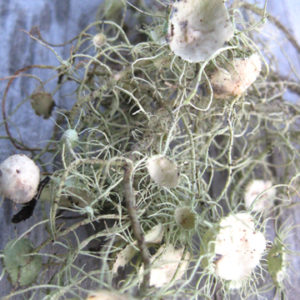Considering Helichrysum
By Dennis Klocek 9 min read
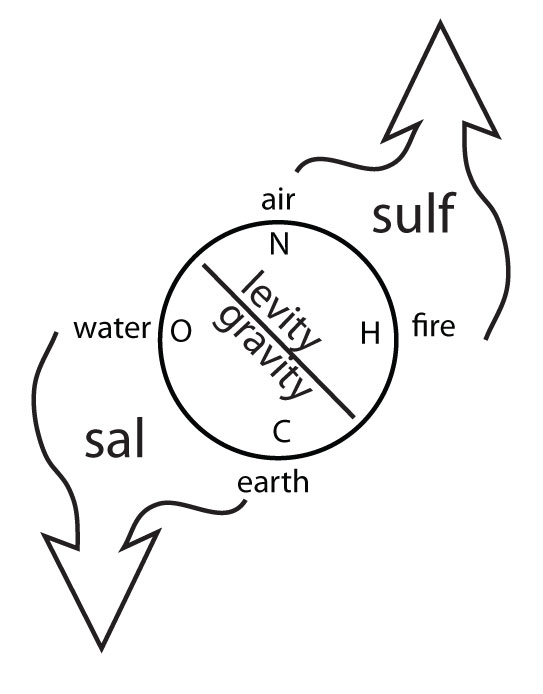
In science today the driving force is to solve mysteries by innovation. Innovation is the clever manipulation of what is already known. As an effective research method for solving technical problems innovation has created wonders. But life evades technical solutions. Uncontrolled pandemics and complex climate change issues result from technical innovation being applied to issues in the life sciences.
The alchemists understood that when dealing with living systems it is better to let the mysteries gradually be revealed in their own way to the mind. Living systems evolve rapidly away from preformed solutions. Living things teach in a way that require the researcher to develop a disciplined imaginative capacity. This is to induce the hidden orders of things. Once a relationship in the natural order is revealed to a receptive, disciplined mind, hidden orders emerge in their own way.
These hidden or we could say inspiring properties point to possible healing potentials in the inherent relationships between humans and plants. Hidden potentials are revealed to imaginative minds. Imagination fosters creativity needed to meet future challenges in living systems that are unprecedented. Innovation lures the mind into rearranging what has worked technically in the past. This approach is too brittle for the evasive and elusive, yet intelligent, order in natural wisdom.
The following article is designed to point out the hidden formative aspects of what contemporary science would see simply as predictable, disparate chemical reactions. The innovative chemistry of today is the corpse of the imaginative science of the alchemists. Their science was based on observation with no preconceptions. That was seen as the right approach to dealing with a mysterious living world.
Their living science has become a remarkably complex shell today. This death process has arisen out of the urge to apply technical solutions to rapidly evolving living systems. By studying life science through technical innovation science has become a maze of complex, abstract naming systems available only to the initiated.

By contrast the use of levity / gravity alchemical relationships can serve as the basis for a systematic, mandalic approach to sequencing natural phenomena. This develops a reliable pictorial based research system available to anyone. Pictorial thinking can support the idea that the macro(species) and micro (hormones) levels of plant development are based on resonant universal patterns inherent at all levels, and in all organisms. Revealing the universal resonant patterns in organisms at all levels opens the door to forming research ideas that can link plant growth to human physiology in profound ways.
The ever evolving challenges of human health can not be solved by technical thinking about the life sciences. The language of a living, growing plant forms, as well as the human embryo is inherently pictorial. The basis for this present work is to show pictorial patterns shared between the molecular diagrams used today to depict plant chemistry and the changes happening in a growing plant form itself . A Lewis diagram for the chlorophyll molecule is an image of a flowering plant.
These formal patterns are inherently resonant in all living things at all levels of inquiry. The hope is that this series of essays will enable a non-scientific person to see more deeply into how medicinal plants interact with the human organism. Those who grow and love plants will find this series challenging but hopefully rewarding of effort.
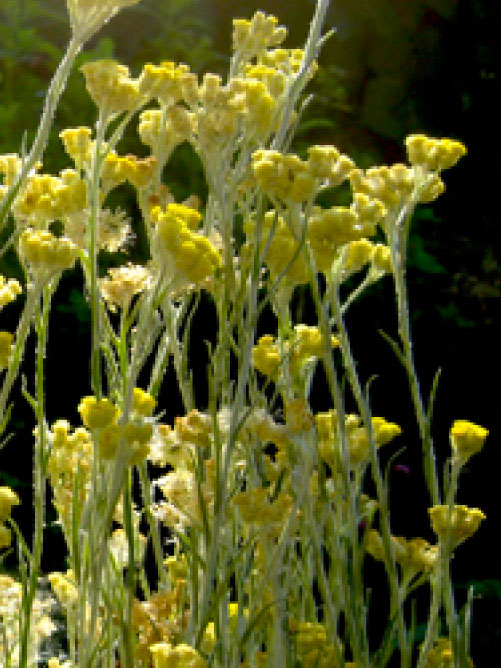
Helichrysum is a powerfully healing member of the Artemisia family. Many healing substances originate in the Artemisias. In a flowering helichrysum plant an oxygenated substance, neryl acetate (alcohol and acid in the form of an ester), results from metabolized chlorophyll in lipid forming pathways in the growing plant. At that time synthesis of terpene hydrocarbons begins as well as the first appearance of more complex molecules.
As the helichrysum turns towards flowering accumulated terpene hydrocarbons in the flower stalk are transformed into oxygenated terpenoids. As anthers are formed for pollination complex chemistry creates complex molecules such as ketones. In helichrysum a rare diketone, italidone, provides a powerful wound healing property in this plant. Ketones are readily oxidized for energy by tissues. Oxidation of ketones produces acetyl coenzyme A an important source of precursors for fatty acids.
In embryonic experiments phospholipids in neural tracts accounted for more than two-thirds of total lipids synthesized from either ketones or glucose. Research reveals that ketones are preferred over glucose as precursors for phospholipids. Cell membranes universally are formed of phospholipids (see previous articles). This relationship suggests the importance of italidone formation in the powerful healing force of helichrysum.
In helichrysum these complex compounds involved in fatty acid creation are rhythmically metabolized in the presence of light and warmth when leaves are growing. As a plant matures past sheer growth, the transformation from growth to flowering generally peaks in the formation of anthers and pollen. Italidone formation is at maximum in the inflorescence at this time.
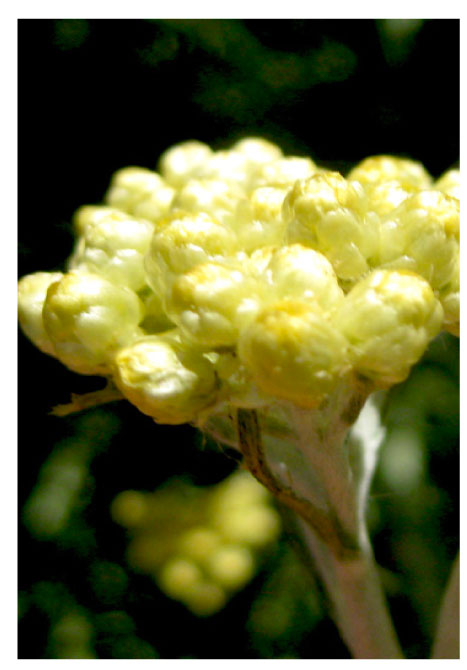
The fragrance in helichrysum is present in the unique combination of terpenoids in the flowers. These substances found in one plant, have strong chemical affinity to the fragrances of the many herbs that make up curry powder. This gives the name curry plant to helichrysum but the flower is not what curry is made from. Fractions found in a single helichrysum plant are oil of curcumene, cineole, eugenol, caryophyllene and pinene. These oils are also found in similar concentrations in turmeric, ginger, cardamom and cloves, herbs that form curry powder.
In helichrysum, this complex of oils found in one plant is metabolized in the last few inches of the flower stalk as flowers are forming. This diminishes these substances in the plant itself but concentrates them in the space below the flower. The healing quality of this flower is from a complex synergy of the many oils. The change from primarily water soluble constituents in the build up to flowering to the more complex di-ketones in the mature inflorescence are key to understanding the harvest potentials present in helichrysum.
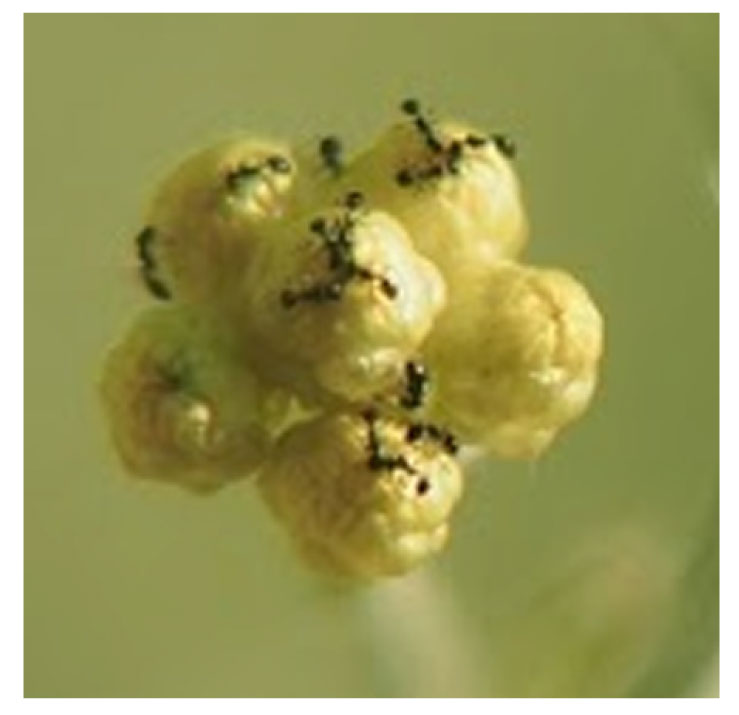
Indications for harvest can be seen in the sequences that unfold in the lengthy flowering process. Helichrysum, like most members of the Artemisia family tends to move through anther formation into full seed production rather quickly. However it stays in the white closed bud build up stage for almost two months. The long bud production builds complex substances in the stalk but the rapid shift to flower and then seed set within a day makes the search for higher oil content phase in distillation challenging.
Some sources assign the remarkable healing force in this flower to the di-ketones but others stress that the particular and unique synergy of components is the true key to the healing power of helichrysum. The helichrysum plants have successfully integrated great complexities. The ants in the photo can’t wait for the flower buds to open so they crawl down a one-ant-wide hole in the yellowing but unopened bud to get their reward. One goes in, then backs out. Then another goes in the same hole and backs out. This goes on for a few days. This indicates good oil potential. When they stop, that flower is ready to form anthers.
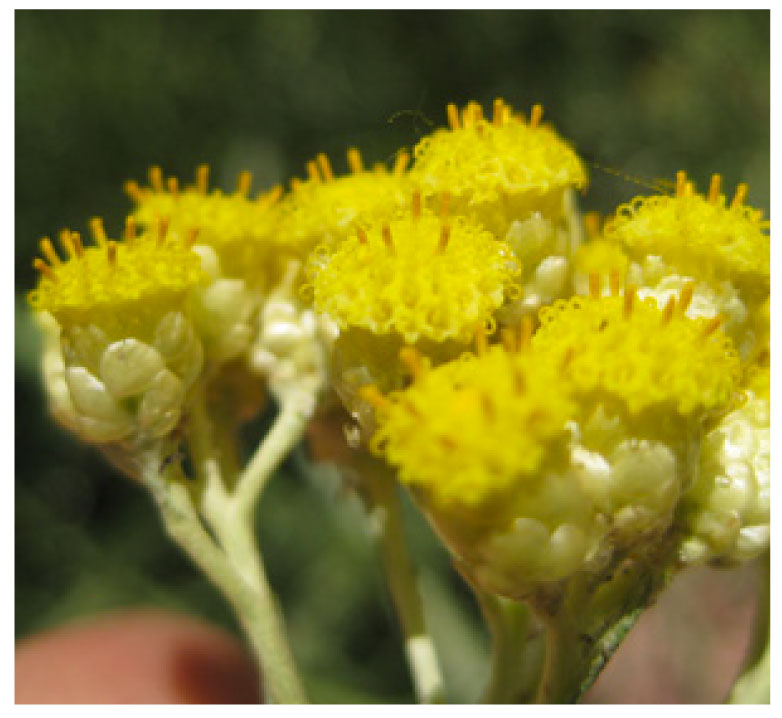
In this image anthers can be seen emerging from the small florets in the flower head. Harvest of helichrysum is traditionally carried out when the plant is in full bloom. The di-ketone italidone and complex terpenoids are synthesized in the stem area of the inflorescence during the long and slow blooming period of a month and a half. This very slow and extended pre-flowering cycle metabolizes the upward moving volatile constituents into the stalk of the flower before flowering.
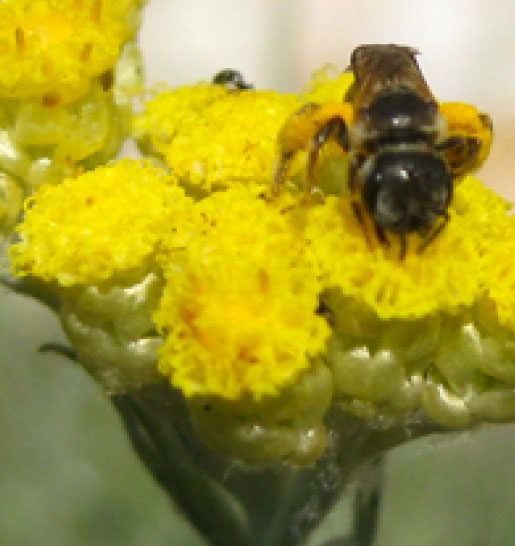
When minute bees, wasps and butterflies visit this indicates that the pollen cycle has begun. The stalk below the inflorescence delivers fully metabolized substances to the flower. This creates strong, complex fragrances. Complex fragrances attract pollinators. The inflorescence breaks buds in stages with five buds in the center setting seed (anthers wither when seed sets) while the rest of the peripheral buds in the inflorescence are still closed. By the time the outer buds have opened the inner florets have set seed. But it takes a few more months for the set seed hanging on the plant to mature enough for seed dispersal that is through the formation of tiny parachutes like a dandelion.
At best, only a very small percentage of essential oil comes from these flowers. In commerce many tons need to be harvested to create only a liter of oil. Images of the commercial harvest of helichrysum show large amounts of the harvested herb in huge steam distillers. Given this difficulty we could ask what is the best time to harvest the plant for the best extraction of its healing oils ?
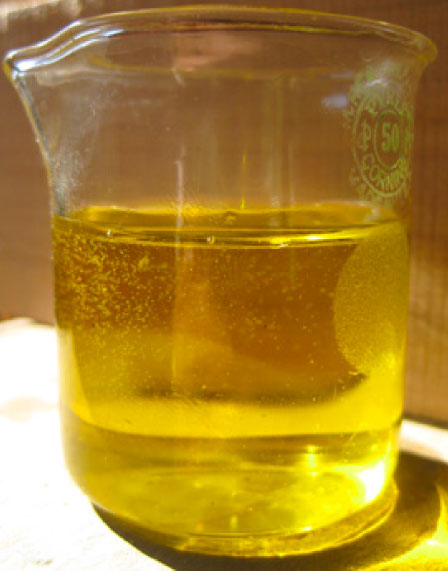
The difference in these stages of growth can be readily experienced by harvesting helichrysum buds prior to anther formation as the color of the bud is white changing to yellow. Put the unopened buds in almond oil in a sealed dark container and set in a warm place for a few weeks. Do a similar operation with helichrysum florets that have a fully opened inflorescence. After a few weeks open each jar and compare the fragrances from each. The experience is a picture of the life of this plant.
If you have distilling equipment, make a hydrosol of flowers as they bloom. Then make a hydrosol distillation from the stalks from which the flowers have been harvested. After a few weeks smell the container with the pre flowering hydrosol and there is little floral fragrance but an acidic almost tart note. Then smell the container with the opened flowers harvested at anthesis and a rich honey note is present. When extracting essential oils these ideas can be illuminating by separating buds, stalks and flowers for different healing effects.
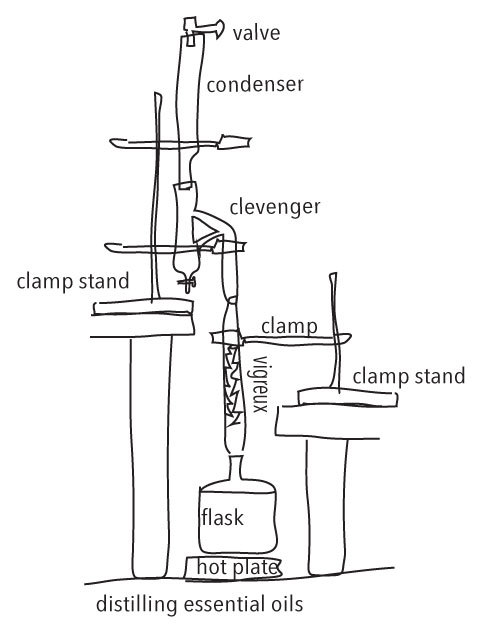
It is also interesting to note that when distilling for essential oils on successive days it can often be experienced that similar plant materials have different oil qualities on different days with everything else being equal. A good practice to experience this to choose several plants with a palpable fragrance as test subjects. Pinch a bud and sniff it to compare the fragrance potential from each plant on that day. Pinch and sniff at two or three different times each day. It can be experienced by this simple test that these plants are remarkably flexible and responsive to the hidden forces in their environment. Their healing potential fluctuates with these responses. This is research that is waiting to be done.
The active properties of many diverse essential oils are shared by many different medicinal plants. Of the main essential oil fractions found in helichrysum the six main oils are found in different proportions in dozens of other plants. Helichrysum is a synthesizing plant. Its power is in the synergies of its components. Coupled with its fundamental relationship to phospholipid cell membranes this cascade of essential oils gives a picture of a remarkably healing plant.

Dennis Klocek
Dennis Klocek, MFA, is co-founder of the Coros Institute, an internationally renowned lecturer, and teacher. He is the author of nine books, including the newly released Colors of the Soul; Esoteric Physiology and also Sacred Agriculture: The Alchemy of Biodynamics. He regularly shares his alchemical, spiritual, and scientific insights at soilsoulandspirit.com.
Similar Writings
The Alchemy of Plant Hormones & Plant Spray Applications
Using the alchemical language of sulf, sal, mercury, Dennis describes how certain minerals and hormones that govern plant growth can be seen as growth patterns of deposition and dissolution.
Understanding of these patterns can be used to select what elements to include in a plant spray.
Scientific Hypotheses – Truth or Error?
[Republished from Journal of Anthroposophical Medicine (JAM) Vol.10 1993] If one were to approach a professional scientist and challenge the hypothetical method as a flawed premise for good science, one would surely be met with vigorous protest. And, indeed, the protest would be well founded, because the hypothetical method is a well-proven cornerstone of scientific…
